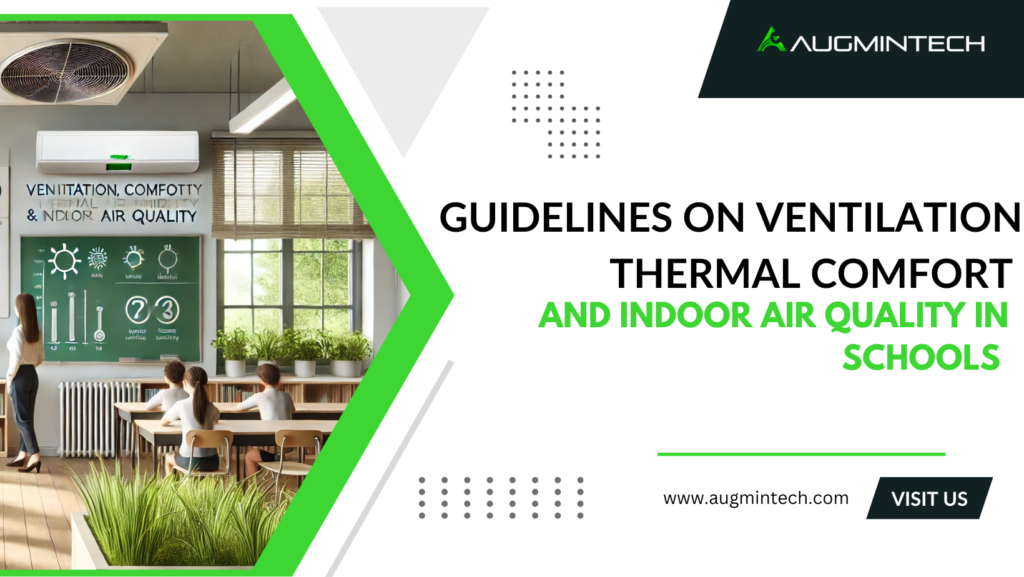Guidelines on Ventilation, Thermal Comfort, and Indoor Air Quality in Schools
- December 29, 2024
- 6:02 pm
- 1300+ Comments

Introduction
In today’s fast-paced world, the demand for skilled HVAC technicians continues to rise. Heating, ventilation, and air conditioning systems are essential for maintaining comfort and efficiency in homes, offices, and industrial settings. If you’re aspiring to build a successful career as an HVAC technician, mastering specific skills is critical. At Augmintech, we are committed to empowering aspiring professionals with the knowledge and training they need to excel in this field.
Table of Contents
Why Are Ventilation and Indoor Air Quality Important in Schools?
Impact on Health: Poor ventilation can lead to higher concentrations of indoor pollutants, triggering allergies, asthma, and other respiratory issues.
Cognitive Performance: Studies show that better IAQ correlates with improved student performance and attention.
Pandemic Precautions: Good ventilation is a vital defense against airborne diseases such as COVID-19.
Key Guidelines for Ventilation in Schools
Ensure Adequate Fresh Air Supply:
Maintain a minimum outdoor airflow rate of 15 cubic feet per minute (CFM) per person as recommended by ASHRAE.
Install operable windows or mechanical ventilation systems.
Use High-Efficiency Filters:
Upgrade HVAC systems with MERV-13 or higher filters to trap fine particles and allergens.
Monitor CO2 Levels:
Keep CO2 levels below 1,000 ppm to ensure fresh air circulation.
Install CO2 sensors in classrooms to monitor air quality.
Regular Maintenance:
Schedule periodic cleaning and servicing of HVAC systems to maintain efficiency and hygiene.
Ensuring Thermal Comfort in Classrooms
Maintain Optimal Temperature:
Set classroom temperatures between 68°F and 74°F (20°C to 23°C) to balance comfort and energy efficiency.
Control Humidity Levels:
Keep relative humidity between 30% and 50% to avoid mold growth and discomfort.
Proper Ventilation Design:
Use ceiling fans, adjustable vents, and air curtains to evenly distribute air.
Energy-Efficient HVAC Systems:
Use programmable thermostats and energy recovery ventilators to reduce energy costs while maintaining comfort.
Improving Indoor Air Quality (IAQ)
Source Control:
Use low-VOC (volatile organic compounds) paints, adhesives, and cleaning products.
Avoid using materials that emit formaldehyde.
Air Purification:
Install portable air purifiers with HEPA filters in classrooms.
Green Spaces:
Incorporate indoor plants that improve air quality, such as snake plants and peace lilies.
Moisture Control:
Repair leaks and ensure proper drainage to prevent mold.
Frequently Asked Questions (FAQs)
1. What is the ideal air change rate for schools?
The ideal air change rate is 5-6 air changes per hour (ACH) in classrooms, as recommended by ASHRAE.
2. How can schools measure indoor air quality?
Schools can use IAQ monitors to measure parameters like CO2, PM2.5, temperature, and humidity levels.
3. What are the common signs of poor IAQ?
Increased absenteeism
Complaints of headaches or fatigue
Visible mold growth
Musty odors
Real-Life Tips for Implementation
Tip 1: Use energy-efficient HVAC systems with demand-controlled ventilation to optimize fresh air supply.
Tip 2: Conduct regular IAQ audits and inspections.
Tip 3: Involve students and staff in maintaining IAQ by educating them about its importance.
Tip 4: Apply for government grants or green certifications to fund IAQ improvements.
Real-Life Tips for Implementation
Highlight Certifications:
Showcase credentials like LEED AP, ASHRAE certifications, or IAQ specialist training.
Prepare Real-Life Scenarios:
Be ready to discuss case studies or projects where you improved IAQ or thermal comfort.
Master Technical Questions:
Know calculations like air change rates and cooling load estimations.
Soft Skills:
Emphasize teamwork and problem-solving abilities.
Free Resource: Downloadable PDF Guide
Get a free downloadable guide that summarizes these guidelines and includes checklists for school administrators. The guide also contains templates for IAQ monitoring and HVAC maintenance schedules.
Conclusion
Proper ventilation, thermal comfort, and indoor air quality are essential for fostering a conducive learning environment in schools. By following these guidelines, schools can safeguard the health and well-being of students and staff while improving academic outcomes. Whether you are an HVAC professional, a school administrator, or an educator, prioritizing these aspects can make a lasting difference.
Take the first step toward healthier schools today!
Take the Next Step in Your HVAC Career
Whether you’re starting fresh or enhancing your current skills, Augmintech offers courses tailored to the needs of HVAC professionals. Enroll in our HVAC Design and Drafting Course to gain hands-on expertise and become job-ready.
